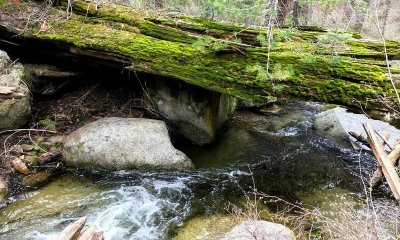
Riparian
Scenario model
Current ecosystem state
Select a state
Management practices/drivers
Select a transition or restoration pathway
- Transition T1 More details
- Restoration pathway R1 More details
-
No transition or restoration pathway between the selected states has been described
Target ecosystem state
Select a state
Description
The riparian areas of the Northern Coast in general are not as floristically diverse as the riparian areas found across much of the rest of the state. The cool climate, lower-gradient streams of LRU I create a fairly consistent variety of adapted species along a fairly narrow band directly adjacent to the streams. The reference state for this site is essentially only dominated by a limited genera of species adapted to the seasonal fluctuations of inundation from precipitation primarily in the forms of upslope surface runoff and groundwater into the valley bottoms, and the cool, foggy climate that limits evapotranspiration rates. There are likely a variety of different riparian ecological sites that have been included in this provisional ecological site concept and should be further investigated to refine the concepts at an individual ecological site scale. At this very general scale, this reference state only really captures the generalities related to the functional groups that are most dominant and does not capture the more specific dynamics and patterns that would be found at the more detailed and refined ecological site scale that focuses on specific abiotic factors that drive some of these various complex plant expressions. More data and refinement is needed to capture the information needed in order to make specific land management decisions at the ecological site-component scale.
Submodel
Description
This state represents the intensive land uses that have significantly altered this ecological site due to primarily to logging, urban developments, and recreational activities. More information about this state is needed to flesh out the various impacts these types of land uses/alterations have had on the ecological site in order to better understand how to better manage of these areas or potentially attempt restoration of these areas where possible.
Submodel
Mechanism
This transition is caused by significant human alterations that force this ecological site over a threshold and change the function and structure of this site in extensive ways.
Mechanism
This restoration pathway occurs only when significant time and money inputs that would require constant maintenance and weed management and should be focused on areas that have not been permanently altered by urban developments. This restoration pathway may require specific growing conditions that may not be replicable due to the alterations to the site that had occurred.
Model keys
Briefcase
Add ecological site groups and Major Land Resource Areas to your briefcase by clicking on the briefcase (![]() ) icon wherever it occurs. Drag and drop items to reorder. Cookies are used to store briefcase items between browsing sessions. Because of this, the number of items that can be added to your briefcase is limited, and briefcase items added on one device and browser cannot be accessed from another device or browser. Users who do not wish to place cookies on their devices should not use the briefcase tool. Briefcase cookies serve no other purpose than described here and are deleted whenever browsing history is cleared.
) icon wherever it occurs. Drag and drop items to reorder. Cookies are used to store briefcase items between browsing sessions. Because of this, the number of items that can be added to your briefcase is limited, and briefcase items added on one device and browser cannot be accessed from another device or browser. Users who do not wish to place cookies on their devices should not use the briefcase tool. Briefcase cookies serve no other purpose than described here and are deleted whenever browsing history is cleared.
Ecological site groups
Major Land Resource Areas
The Ecosystem Dynamics Interpretive Tool is an information system framework developed by the USDA-ARS Jornada Experimental Range, USDA Natural Resources Conservation Service, and New Mexico State University.
